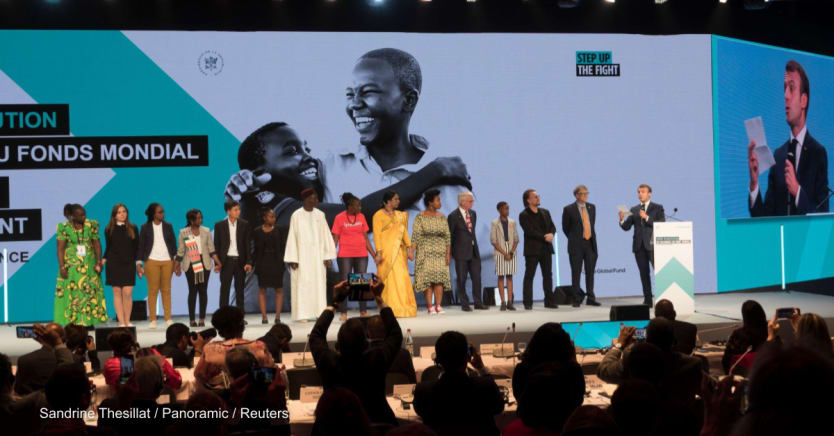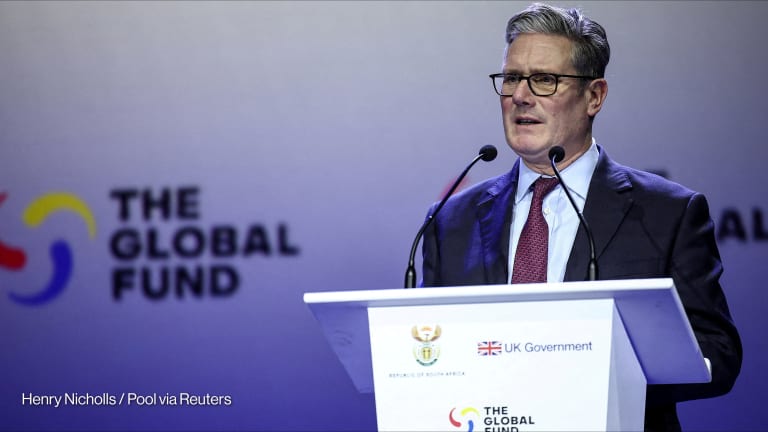
On Sept. 21, the United States is hosting the seventh replenishment of the Global Fund to Fight AIDS, Tuberculosis and Malaria, which hopes to raise at least $18 billion for its work in the next three years.
So far, the fund has received pledges amounting to almost half of its funding goal — roughly $8.8 billion — with the U.S. pledging the largest amount of $6 billion, according to a list of pledges the fund shared with Devex. The other big pledges came from Germany and Japan, which announced $1.3 billion and $1.08 billion, respectively, in recent weeks.
Global Fund Executive Director Peter Sands is well aware of the challenges the fund is up against in raising funding amid the presence of multiple crises. Countries are still reeling from the economic impact of the COVID-19 pandemic, and the war in Ukraine is putting additional strain on countries’ resources as prices of food and energy rise.
In addition, Sands told Devex in Montreal that a global economic recession may lead to pressure on domestic health financing, which could have an impact on the funding they expect countries would spend to address HIV and AIDS, tuberculosis, and malaria.
But without the full $18 billion, it will be difficult to get the world back on track to ending HIV, TB, and malaria by 2030. According to the fund’s investment case, the $18 billion is the minimum amount of resources needed to address the three diseases in the countries it invests in. The total resources needed — which will require significant domestic funding — is $130.2 billion.
But some Global Fund supporters are optimistic it will be able to raise the resources it needs for the next three years.
“This year we expect a lot of the pledges to come in [on] the day of the pledging event itself. The really strong pledges from the US, Japan and Germany are all good signs. We are on track to have the most successful replenishment ever,” Chris Collins, president and CEO of the Friends of the Global Fight Against AIDS, Tuberculosis and Malaria, wrote to Devex.
He said additional pledges can come even after the pledging conference.
A Global Fund spokesman wrote to Devex that recent pledges from Germany, Japan, and private sector donors such as the Children’s Investment Fund Foundation that show an increase of 30% from their previous contributions to the fund “are very strong signals of our donors’ continued commitment despite the difficult context in which we are.”
Most funding announcements take place during the replenishment conference, and the fund sees the early pledges as a “sign of confidence” in the organization, the spokesman added.
A short history of Global Fund replenishments
In 2019, at its sixth replenishment conference, the Global Fund topped its funding goal, receiving $14.02 billion in pledges and commitments. As of June 2022, out of this amount, actual donor contributions total $11.9 billion.
Reaching the replenishment goal of $14 billion was “pretty intense,” Sands described back then. To reach it, both France, the host country, and the Bill & Melinda Gates Foundation had to make additional funding pledges. Bill Gates, French President Emmanuel Macron, and U2 singer Bono, co-founder of RED, also committed to raise a further $100 million during the 2020-2022 replenishment period.
“What global leaders need to understand is that we can’t afford a zero-sum game approach in tackling international challenges.”
— Chris Collins, president and CEO, Friends of the Global Fight Against AIDS, Tuberculosis and MalariaBut the seventh replenishment is taking place under a different global context.
“This [seventh] replenishment was launched in February, the day before the Ukraine war started. That war has changed the context for replenishment, placing new demands on donor[s] and implementing governments alike,” Collins said.
Past replenishment conferences didn’t always meet the fundraising targets. In 2016, at its fifth replenishment, the Global Fund was roughly $100 million shy of its $13 billion target. And in 2013, at its fourth replenishment, it raised just over $12 billion of its $15 billion target.
Sands has mentioned the need for the fund to broaden its donor base. The U.S. is the Global Fund’s largest donor, and has contributed $20.97 billion to the fund to date. But a law limits U.S. contributions to the fund to only one-third of its total funding. That means the $6 billion that the Biden administration pledged for the Fund’s seventh replenishment can only be realized if other donors pledged at least $12 billion.
At its sixth replenishment, the Global Fund saw over 30 new or returning donors, including several African countries, NGOs, and private companies. It also received large pledges from France and the U.K., which rank second and third among Global Fund government donors. Both countries, however, have yet to make any public pledges ahead of the seventh replenishment, as well as Canada, the European Commission, Italy, and the Netherlands, which make up the fund’s top 10 government donors.
"The wealthiest countries in the world are dangerously close to delivering Global Fund replenishment failure. Defeating today's pandemics comes down to a simple test of political will--It is not a question of whether or not the money is available. The whole world is watching Truss, Trudeau, and other politicians that have resisted pledging,” Asia Russell, executive director of Health GAP, wrote to Devex.
A world off track
In its latest Results Report published this week, the Global Fund said the programs it has supported have saved 50 million lives as of the end of 2021. A total of 23.3 million people are now on antiretroviral therapy, 5.3 million are treated for tuberculosis, and Global Fund partners have distributed 133.2 million mosquito nets, which help protect populations from malaria.
The report, however, reveals how some programs have been hit hard by the pandemic. TB treatment coverage has decreased from 69% in 2019 to 57% in 2020. Only 52% of children with HIV are receiving treatment. In West and Central Africa, only 60% of pregnant women with HIV are getting treatment.
Global Fund grants in 2021 accounted for 30% of all international HIV financing, 76% of all international TB financing, and 63% of all international malaria financing.
But more resources are needed, and donors need to pledge more money at the pledging conference next week, according to Medecins Sans Frontieres, an international medical organization. Even if the Global Fund raises $18 billion next week — which MSF says is “the floor and not the ceiling” — there remains a huge global funding gap for HIV, TB, and malaria of about $28.4 billion.
In a recently published report, MSF details a reversal in progress in addressing HIV, TB, and malaria in several countries. TB infections have increased in countries such as Guinea, South Sudan, and Mozambique. In MSF clinics in Kachin and Shan states in Myanmar, the organization reported an increase from 54.8% to 82.3% in the number of patients presenting with advanced HIV disease. In some places, Global Fund grants are unable to cover several interventions because of limited funding, such as voluntary HIV counseling and testing services in the Central African Republic.
“What global leaders need to understand is that we can’t afford a zero-sum game approach in tackling international challenges. The success or failure of Global Fund replenishment will be counted in millions of lives,” Collins said.









